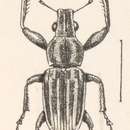Description
provided by INOTAXA archive
Rostrum broad, subquadrate, flattened, notched at the tip, the bare nasal plate extremely short, the scrobes lateral, sinuous, and descending to beneath the eyes, the latter strictly lateral, convex, and very prominent, the head narrowly extended behind them; mentum small, transverse, almost filling the buccal cavity, arising from a short peduncle; mandibles with a large scar in front; antennæ long and slender, joint 2 of the funiculus about twice as long as 1, the scape nearly or quite reaching the front of the prothorax; prothorax deeply sinuate and broadly margined (as seen from behind) at the base; scutellum small; elytra much wider than the prothorax, sinuate at the base, with rather prominent humeri, 10-striate, the outer striæ approximate from basal third; femora clavate, unarmed, the anterior pair stout; anterior tibiæ denticulate; posterior tibiæ with the apex laminate and squamose, the glabrous articular surface cavernous and ascending; tarsi with the basal joint rather long, the claws free; body winged, squamose, in life clothed with a powdery exudation.
- license
- cc-by-3.0
- copyright
- Biologia Centrali-Americana
Physical description
provided by INOTAXA archive
The genus Naupactus is here restricted to the winged forms only (type Curculio rivulosus, F.), Dr. Sharp having already (anteà, p. 152) transferred the apterous ones to Pantomorus (= Aramigus and Phacepholis, Horn). Schönherr included 140 species in it, the winged representatives belonging to the Stirps IV. of his later work. The essential characters of the three Central-American forms known to me are as follows:—
Champion in: David Sharp & G. C. Champion, May 1911. Biol. Centr.-Amer.,Coleoptera, vol. 4, pt. 3: 232.
- license
- cc-by-3.0
- copyright
- Biologia Centrali-Americana

